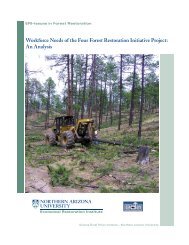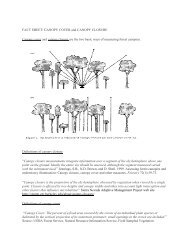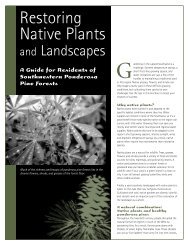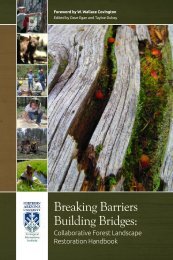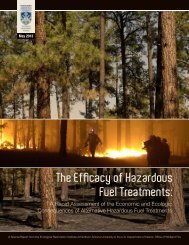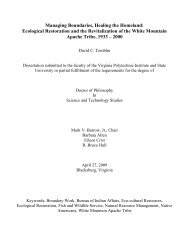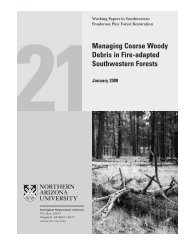Did Tallgrass Prairie Extend into Pennsylvania? - ERI Library ...
Did Tallgrass Prairie Extend into Pennsylvania? - ERI Library ...
Did Tallgrass Prairie Extend into Pennsylvania? - ERI Library ...
You also want an ePaper? Increase the reach of your titles
YUMPU automatically turns print PDFs into web optimized ePapers that Google loves.
Laughlin: <strong>Prairie</strong>s in <strong>Pennsylvania</strong>13Therefore, the eastern boundary of climatic conditions that could allow for prairie/savanna dominance was in western <strong>Pennsylvania</strong> and that the climate east (andnorth and south) of this boundary was suitable for the eastern deciduous forest.Most scholars suggest that the grasslands of the <strong>Prairie</strong> Peninsula reachedpeak distribution during a time of global drought, known as the HypsithermalInterval (8000 to 4000 YBP), when the western species more adapted to dry climatesmigrated toward the east (Stuckey 1981, Webb et al. 1983, Baskin et a!. 1994). Amore recent warm and dry period known as the "Medieval Warm Period" or"Medieval Climatic Optimum" also occurred globally and locally in North Americafrom ca. A.D. 900 to 1300 (Brush 1991, Luckman 1994). This period has beenassociated with more frequent wild fires (Brush 1991) and the development of oak(Quercus spp.) savannas (Nuzzo 1985). During cooler and wetter times, thegrassland has been colonized by forest, but research strongly suggested that manylarge remnants throughout the Midwestern states persisted because of a frequentfire regime (Gleason 1923, Pyne 1987, Heikens and Robertson 1994). Therefore, noclear and simple relationship has been shown to exist between climate and thedistribution of grassland because other factors, such as fire and grazing animals,played significant and integral roles (Anderson 1982).The easternmost extension of the <strong>Prairie</strong> Peninsula is disputed, but manyscholars have drawn the boundary in central or eastern Ohio based on extantrelicts of tallgrass vegetation (Gray 1878, Adams 1902, Braun 1921, Gleason 1923,Schaffner 1926, Braun 1928a, 1928b, 1950, Anderson 1983). The easternmostbluestem prairie in Kuchler's (1964) map of potential natural vegetation of theUnited States was in west-central Ohio; <strong>Pennsylvania</strong> was composed almostentirely of Appalachian oak (Quercus spp.) and Northern Hardwood forests. Also,Delcourt and Delcourt (1981) did not show any type of grassland community in<strong>Pennsylvania</strong> in their vegetation maps for eastern North America from 40,000 YBPto the present. Today, however, <strong>Pennsylvania</strong> hosts three distinct prairie-types.These are the "blazing star prairies" of western <strong>Pennsylvania</strong> (Jennings 1939,Aaron 1974), the serpentine barrens and grasslands of the Piedmont Province (Fike1999, Tyndall and Hull 1999), and the xeric limestone prairies (sensu Baskin et a!.1994 and Baskin and Baskin 2000) of the Ridge and Valley Physiographic Province(Laughlin and Uhl 2003).The Big Barrens of Kentucky and Tennessee once was considered part ofthe <strong>Prairie</strong> Peninsula by Transeau (1935), but Baskin and Baskin (1981) andBaskin et al. (1994) used geological, edaphic, botanical, and paleobotanical datato determine that it was not part of the <strong>Prairie</strong> Peninsula. Transeau's (1905,1935) analysis of climatic data suggested that the <strong>Prairie</strong> Peninsula also mighthave extended <strong>into</strong> <strong>Pennsylvania</strong>. If the <strong>Prairie</strong> Peninsula did extend <strong>into</strong><strong>Pennsylvania</strong>, then one would expect to find remnants of mesic tallgrassvegetation. Through reviews of the literature I examined the plant speciescomposition and abiotic conditions of prairie communities throughout Pennsyl



